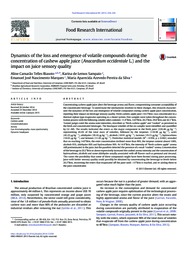Dynamics of the loss and emergence of volatile compounds during the concentration of cashew apple juice (Anacardium occidentale L.) and the impact on juice sensory quality.
Dynamics of the loss and emergence of volatile compounds during the concentration of cashew apple juice (Anacardium occidentale L.) and the impact on juice sensory quality.
Author(s): BIASOTO, A. C. T.; SAMPAIO, K. de L.; MARQUES, E. J. N.; SILVA, M. A. A. P. da
Summary: Concentrating cashew apple juice alters the beverage aroma and flavor, compromising consumer acceptability of the concentrated beverage. To understand the mechanisms involved in these changes, this research characterized the dynamics of the loss and emergence of volatile compounds during cashew apple juice concentration, reporting their impact on beverage sensory quality. Fresh cashew apple juice (10.3°Brix) was concentrated in a thermal-siphon type evaporator operating in a closed system. Five samples were taken throughout the concentration process with the following soluble solids contents: 11.8°Brix, 14.9°Brix, 20.2°Brix, 29.6°Brix and 42.1°Brix. Trained judges rated the aroma note intensities, described as ?fresh cashew apple? and ?cooked? as perceived in the fresh and concentrated beverages. The headspace volatiles of the six samples were identified and quantified by GC?MS. The results indicated the esters as the major component in the fresh juice (226.46 μg kg− 1) representing 45.0% of the total mass of volatiles, followed by the terpenes (118.98 μg kg− 1), acids (45.23 μg kg− 1), aldehydes (39.10 μg kg− 1), alcohols (18.91 μg kg− 1), lactones (19.15 μg kg− 1), hydrocarbons (18.02 μg kg− 1) and ketones (11.05 μg kg− 1). Predictive statistical models (R2 > 0.956, p ≤ 0.002) revealed that on reaching 14.9°Brix, the ester concentration declined more than 90%, the terpene content almost 100%, alcohols 85%, aldehydes 80% and hydrocarbons 90%. At 14.9°Brix, the intensity of ?fresh cashew apple? aroma still predominated in the juice, but the panelists detected the presence of a weak ?cooked? aroma. Concentration of the beverage to 20.2°Brix or above expressively increased the cooked aroma intensity and the concentration of hydrocarbons, alcohols and some aldehydes usually associated with off-flavors such as pentanal and decanal. This raises the possibility that some of these compounds might have been formed during juice processing. Juice with better sensory quality could possibly be obtained by concentrating the beverage to levels below 20.2°Brix, recovering the esters that evaporated off the juice until ~ 15°Brix is reached, and re-adding them to the juice concentrated.
Publication year: 2015
Types of publication: Journal article
Unit: Embrapa Semi-arid Region
Observation
Some of Embrapa's publications are published as ePub files. To read them, use or download one of the following free software options to your computer or mobile device. Android: Google Play Books; IOS: iBooks; Windows and Linux: Calibre.
Access other publications
Access the Agricultural Research Database (BDPA) to consult Embrapa's full library collection and records.
Visit Embrapa Bookstore to purchase books and other publications sold by Embrapa.

